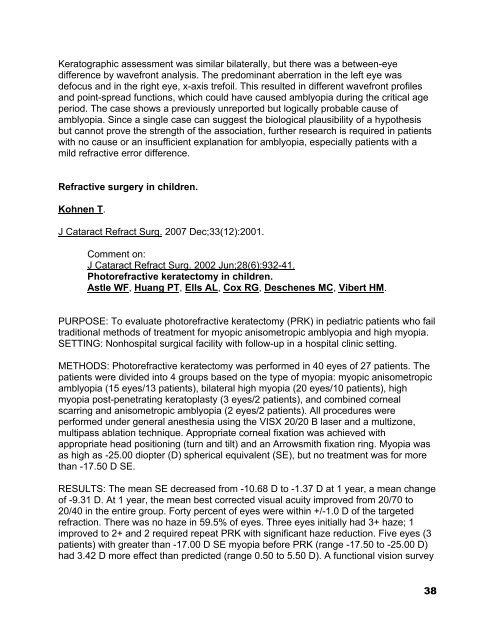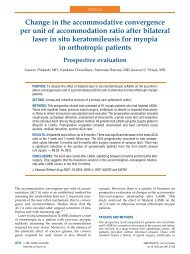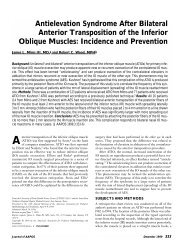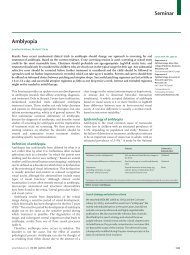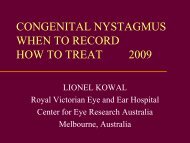What's new AAPOS 2008 - The Private Eye Clinic
What's new AAPOS 2008 - The Private Eye Clinic
What's new AAPOS 2008 - The Private Eye Clinic
Create successful ePaper yourself
Turn your PDF publications into a flip-book with our unique Google optimized e-Paper software.
Keratographic assessment was similar bilaterally, but there was a between-eye<br />
difference by wavefront analysis. <strong>The</strong> predominant aberration in the left eye was<br />
defocus and in the right eye, x-axis trefoil. This resulted in different wavefront profiles<br />
and point-spread functions, which could have caused amblyopia during the critical age<br />
period. <strong>The</strong> case shows a previously unreported but logically probable cause of<br />
amblyopia. Since a single case can suggest the biological plausibility of a hypothesis<br />
but cannot prove the strength of the association, further research is required in patients<br />
with no cause or an insufficient explanation for amblyopia, especially patients with a<br />
mild refractive error difference.<br />
Refractive surgery in children.<br />
Kohnen T.<br />
J Cataract Refract Surg. 2007 Dec;33(12):2001.<br />
Comment on:<br />
J Cataract Refract Surg. 2002 Jun;28(6):932-41.<br />
Photorefractive keratectomy in children.<br />
Astle WF, Huang PT, Ells AL, Cox RG, Deschenes MC, Vibert HM.<br />
PURPOSE: To evaluate photorefractive keratectomy (PRK) in pediatric patients who fail<br />
traditional methods of treatment for myopic anisometropic amblyopia and high myopia.<br />
SETTING: Nonhospital surgical facility with follow-up in a hospital clinic setting.<br />
METHODS: Photorefractive keratectomy was performed in 40 eyes of 27 patients. <strong>The</strong><br />
patients were divided into 4 groups based on the type of myopia: myopic anisometropic<br />
amblyopia (15 eyes/13 patients), bilateral high myopia (20 eyes/10 patients), high<br />
myopia post-penetrating keratoplasty (3 eyes/2 patients), and combined corneal<br />
scarring and anisometropic amblyopia (2 eyes/2 patients). All procedures were<br />
performed under general anesthesia using the VISX 20/20 B laser and a multizone,<br />
multipass ablation technique. Appropriate corneal fixation was achieved with<br />
appropriate head positioning (turn and tilt) and an Arrowsmith fixation ring. Myopia was<br />
as high as -25.00 diopter (D) spherical equivalent (SE), but no treatment was for more<br />
than -17.50 D SE.<br />
RESULTS: <strong>The</strong> mean SE decreased from -10.68 D to -1.37 D at 1 year, a mean change<br />
of -9.31 D. At 1 year, the mean best corrected visual acuity improved from 20/70 to<br />
20/40 in the entire group. Forty percent of eyes were within +/-1.0 D of the targeted<br />
refraction. <strong>The</strong>re was no haze in 59.5% of eyes. Three eyes initially had 3+ haze; 1<br />
improved to 2+ and 2 required repeat PRK with significant haze reduction. Five eyes (3<br />
patients) with greater than -17.00 D SE myopia before PRK (range -17.50 to -25.00 D)<br />
had 3.42 D more effect than predicted (range 0.50 to 5.50 D). A functional vision survey<br />
38


